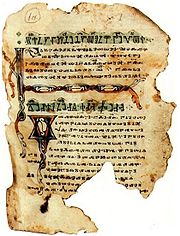
Euchologium Sinaiticum
Encyclopedia

Old Church Slavonic
Old Church Slavonic or Old Church Slavic was the first literary Slavic language, first developed by the 9th century Byzantine Greek missionaries Saints Cyril and Methodius who were credited with standardizing the language and using it for translating the Bible and other Ancient Greek...
canon euchologium. It contains parts of the liturgy of the St. John Chrysostom
John Chrysostom
John Chrysostom , Archbishop of Constantinople, was an important Early Church Father. He is known for his eloquence in preaching and public speaking, his denunciation of abuse of authority by both ecclesiastical and political leaders, the Divine Liturgy of St. John Chrysostom, and his ascetic...
, and is dated to the 11th century.
The manuscript was found in the monastery of Saint Catherine's Monastery, Mount Sinai
Saint Catherine's Monastery, Mount Sinai
Saint Catherine's Monastery lies on the Sinai Peninsula, at the mouth of a gorge at the foot of Mount Sinai in the city of Saint Catherine in Egypt's South Sinai Governorate. The monastery is Orthodox and is a UNESCO World Heritage Site...
in 1850 by the Russian archimandrite
Archimandrite
The title Archimandrite , primarily used in the Eastern Orthodox and the Eastern Catholic churches, originally referred to a superior abbot whom a bishop appointed to supervise...
Porfirij Uspensky, and there it's still kept today excepting the three folios taken by Uspenskij and N.P. Krylov to Saint Petersburg, Russia. Among the Sinai manuscripts discovered in 1975 is a 28-folio fragment of the Euchologium Sinaiticum.
It was first published by Czech L.Leitler in 1882 in Zagreb. In the edition Patrologia Orientalis
Patrologia Orientalis
The Patrologia Orientalis is an attempt to create a comprehensive collection of the writings by eastern Church Fathers in Syriac, Armenian, Arabic, Coptic, Ge'ez, Georgian, and Slavonic. It is designed to complement the comprehensive, influential, and monumental Latin and Greek patrologies...
(t. XXIV, fasc. 5, 1933, p. 605-802 and t. XXV, fasc. 3, 1939, p. 487-617) it was published by J. Frček. Slovene Slavist R. Nahitagal published it in Ljubljana photographically in 1941, and in 1942 in Cyrillic transcription. Recent edition has been by I. C. Tarnanidis: The Slavonic Manuscripts Discovered in 1975. at St. Catherine's Monastery on Mount Sinai (Thessaloniki, 1988).
Researchers emphasize that the manuscript is a collection of diverse prayers of different origins: some of them are scribed to the pre-Cyrillo-Methodian Salzburg mission, and for others it's being claimed that they represent Eastern-rite missal fragments. We don't know much of its language: nasal vowels are well-preserved, there is no notation of palatalness in syllabic sonorants r and l, strong yer
Yer
The letter yer of the Cyrillic alphabet, also spelled jer or er, is known as the hard sign in the modern Russian and Rusyn alphabets and as er golyam in the Bulgarian alphabet...
s are sometimes preserved, and sometimes vocalized (ъ > o, ь > e), weak yers are sometimes omitted, Jagić's rule is confirmed etc.

